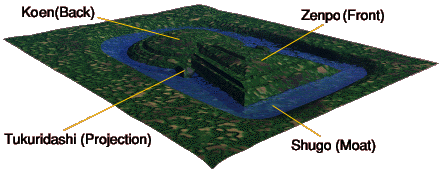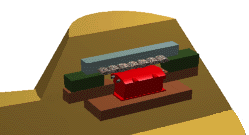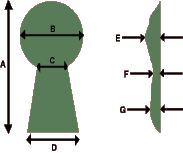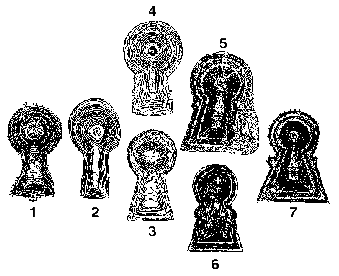|
Kofun, keyhole shaped tomb mounds, are the most famous monuments of ancient Japan. Exactly those are kinds of tomb mounds for ancient powerful clans or emperors. Why are they keyhole shaped? That is a most interesting question. But that is still unknown. Kofun is the symbol of "Kofun Period", providing important information
to solve secrets in the ancient world.
When you are interested in archaeological research, computer is a powerful tool to handle archaeological data: Archaeology
is a science based on accumulation of physical or quantitative data and information. Recent innovation in computer technology gradually changes archaeology. A large amount of archaeological data can so quickly be handled by computer that new knowledge or facts of ancient Japan would hopely be obtained.
Basic knowledge
If you don't have knowledge of Kofun, "Keyhole shaped tomb mounds", you can see here. Here are some basic knowledge, containing historical background of Kofun, distribution map, names of parts (external and internal of Kofun), burial treasures and so on. But we are sorry not to offer any other knowledge now. In order to improve this homepage better and better, suggestion or comments given by a lot of people would be appreciated. And if you have a question, send E-mail to us. As possible as we can, we will offer you some information of the question!
Our research, Dating
Kofun changed their shape from the early Kofun period to the late period. So we have been building a detabase of Kofun's shapes for about 20 years. The database now plays very important role in archaeological study on kofun. When we made dating of Kofun, we consider dimensions of seven parts of the tomb. The seven dimensions include length of tomb, width of front, radius of back, width of the neck, height of front, height of the neck and height of back. Recent reserches show that the seven parts of the tomb are very important for dating Kofun. Here are traditional history of Kofun shapes!

Basic knowledge
Historical background where Kofun were built
In the Kofun-Period, local leaders were religiously authorized. Thier powers became bigger and bigger
by leading civil engineering operations such as river improvement or agricultural watering
and religious ceremonies in the period. Even if a leader died, people would be hoping he could continue to protect
their lives by his magical power. It might be a possible story that Kofun was a symbol of such religious power. The supreme
power in Yamato area gradually united and controlled all local leaders. This would be one of
the reason why Kofun were built all over the country.

A distribution map of Kofun in Japan
This is a map within some kofuns which are more than 100 meters. But in fact there are a lot of another kofuns.

Kofun-Period in details
Kofun period between 4th and 6th century have been devided into subperiods in the following ways:
(1)Dividing Kofun-Period into three subperiods:
the early (4th century), the middle (5th century), the late (6th-7th century)
(2)Dividing Kofun-Period into seven subperiods:
the early1,2,3,4(4th-5th century), and the late1,2,3(6th-7th century)
External features of Kofun
Tukuridashi (Projections)
It is a protruding platform connecting to the neck(narrow part). It is semicircle shaped or square shaped. Archaeologically it is estimated to be used for an alter.
Shugou (Moat)
In most cases, moat is surrounding a Kofun. Some big Kofun have two or more moats. Shape of the moat is similar to Keyhole also or a hoof of horses.

Internal features of Kofun
Coffin
Coffin was used for protection of a dead. It is classified into the several types by the materials, which include the wood, stone, Haniwa and earthenware coffins. And it also is classified by shapes; house, a half of bamboo,roof of house, and boat.
Stone chamber
Building structure to preserve and protect coffins. It is roughly classified into two types; pit-styled and cave-styled.
A pit-styled chamber was made for only one dead. After the dead in a coffin was burried, the chamber was completely closed by ceiling stones. A cave-styled chamber has a stone door which is able to be reopened and closed. Then it could accept more than two coffins. The cave-styled chamber has a passage to the outside. All of those are made of stone.
Kaku
Kaku protects a coffin as well as a stone chamber. What is the difference between a stone chamber and Kaku? If there is enough space between a coffin and ceiling, it is called a stone chamber. Otherwise, it is Kaku. Note this is not a strict definition. Kaku is classified into the clay type, charcoal type and gravel type.

Burial treasures
Haniwa of Kofun
Origin of Haniwa.......
Haniwa is a special type of pottery, of which shape is from human, animal or other things. We have a tale that human-shaped Haniwa was employed instead of self-immolation. Even today, Haniwa can be found over the surface of almost every tomb mounds. Archaeologically, there is, however, no evidence of self-immolation in the ancient Japan.
Treasures accompanied by a dead
mirrors, accessories(jewel, crown, earring, ring, etc.), weapons, armors, harnesses, farm instruments, tools, finishing instruments, many things made of stone, imitations made of stone, metals, potteries, etc.
Potteries are classified into Hajiki and Sueki. Hajiki originated in Yayoi Period, just before Kofun Period. Sueki originated in Kofun Period, which were made in higer temprature than Hajiki.

Our Research
The seven dimensions
 For dating of Kofun, we consider dimensions of seven parts of the tomb (length of tomb, width of front, radius of back, width of the neck ,height of front, height of the neck and height of back).
For dating of Kofun, we consider dimensions of seven parts of the tomb (length of tomb, width of front, radius of back, width of the neck ,height of front, height of the neck and height of back).
A.........length of tomb
B.........width of front
C.........width of the neck
D.........radius of back
E.........height of front
F.........height of the neck
G.........height of back
Change of Kofun's shapes
Kofun were gradually changed in their shapes. Our statistical researches on their shapes makes it clear that Kofun can be classified into seven groups.
Group 1, Hashihaka-type
Hashihaka-type is one of the oldest types around the beginning of 4th century. The famous Hashihaka-Kofun in Nara is the representative of this type.
The front opens, drawing two curved lines. This is a very specific point of this type.The mound has three terraces at the front and five at the back. Further, note that the side of the front was built without terraces. On the other hand, a ravine of the neck is not straight. It is a minority example.
Group 2, Sakurai-Chausuyama-type (development of Kofun)
This type of Kofun appeared a little later than group 1. Sakurai-Chausuyama tomb in Nara is the representative of this type.
Group 3, Suinin-type
This type appeared around the end of 4th century, of which representative is Mousoleum of the Emperor Suinin near Nara city. This type of Kofun were built in the late of the Early Kofun Period. Suinin type is more regular in shape than the others in the Early Kofun Period. For example, compared with the characteristics of the other Early types, the neck becomes wider. But this type takes over the characteristics of Sakurai-Chausuyama type as to the height of the front part.
Group 4, Hihasumehime-type
Compared with Sakurai-Chausuyama or Suinin-type, They have very short square fronts. The representative is Mausoleum of the Empress Hihasuhime near Nara city. By quantitative analysis, this type of mound was derived from the building plan of Suinin-type.
Group 5, Ojin-type
This type was evolved from Suinin-type. Almost all existing Kofun belong to this type, the typical "Keyhole tomb". But we still can find a little bit of changes within this type. The representative is Mausoleum of the Emperor Ojin.
Group 6, Nintoku-type
A specific point of this type is that they have very long square front compared with the previous type. This type is regarded as a special one derived from Ojin type. Mausoleum of the Emperor Nintoku is the representative, which is the biggest tomb mound in the world. This type influenced on the later Kofun.
Group 7, Haji-Nisanzai-type
This type is defined as the latest type in the Kofun-Period, taking over the characteristics of Ojin-type. But from the viewpoint of design of shape, this type includes all existing elements, being characterized by the long square front. In short, this type was built on the basis of Ojin-type. Archaeologically, its plan appeared around the end of 5th century.


*Don't make any link to another homepage without our permission.
*This is the version 1.0 constructed in January 1998.
| 
